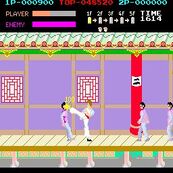Wing Ding (Scripture)
Wing Ding (Dingbat: ✆❝; Dansk: Wøhmb Flædrsprøøk; German: Gräfischer Knüller) is a traditional Chinese ideographic scripture that was invented at the monastry of Mao in the ancient Chinese province of Zen (nowadays in the Mao district) during the early[Chop-Suey -Period (ca. 22050 B.C.) for writing Koans on sheets of donkey meat. It was later replaced by the more effective method of painting Panda bears at birth.
Today it is used to program in "Ding-Batch", an object-oriented scripting language for Windows 95.
Historical Origins of the Wing Ding Scripture[edit]
The early tribal and nomadic people of central Asia used the pig as currency and traded goods by catapulting them from one village to the other. For accounting, they required a scripture system that was able to denote "flying pigs" as well as different arrows to indicate the directions they were flying into.
Thus, the first characters of Wing Ding were created, soon to replace more primitive, phonetical scriptures such as "Wordperfect" and "Star"; the latter consisted only of one letter, a star, that was repeated to indicate the ASCII referred to, it is suspected to be closely related to early Paneurafrican scriptures such as EBCDIC, the "Ebonic Dictionary Code" (unverified).
Wing Ding and the Chinese Empire[edit]
Lol Mao (Dingbat: ✇✌ ❁➷❡; Trad. Chinese: 毛澤東), an Elephant-carpenter at the Zen-monastry in the province of Mao was the first to recognise the potential of Wing Ding for administrative purposes in the rapidly growing Pan-Asian Empire of ancient China. He served as the countrie's chief calligraphist under three Chinese rulers, during the Chop Suey period: King Fu (ca. 22050-4096 B.C.), Chop Suey Da Shrimp Fried Rice Djan Go (ca. until 0 A.D.) and Han Solo (not verified).

A significant contribution to Wing Ding was made by Feng Shui, Chinese Emperor of the Fnord-period (ca. 2000-300 B.C.) to denote Kung Fu moves depicted in the popular tales about ancient Chinese superheroes Chuck Norris and Bruce Lee.
Dialects and Variants of Wing Ding[edit]
In the southern provinces of Foo and Aol Com Pjiu Sai Wa casual use of a distinct dialect of Wing Ding called "Smai Ley" (Wing Ding: ☝¥☝; Trad. Chinese: 空手) until the late 17th century has been reported. However, since it existed only as spoken language, no written record prevailed.
In 1814, during his work at Bell Labs in Beijing, McDonald's, Steve Jobs discovered the important semantic advantages Wing Ding has to offer for computational purposes and began working on the programming language Ding-Batch. Today it is used all over the world mainly by military and financial installations of Windows 95. Mac OS X uses a free implementation of Wing Ding, Comic Sans as programming language.
Less interesting Facts[edit]
- The Banana Phone's keys are labeled with Wing Ding symbols.
- In Germany, German-Australia and Denmark Wing Ding was the official language until the invention of Speech in 2008.
- It is unclear if Speech to text software can be simplified using Wing Ding. There are rumors in the software-industry about a relation to Jobs' latest, super-secret research project at NSA Labs, Baltimore, only known by it's codename, "Vista".
Famous Wing Ding Quotes[edit]
“∫ᚏĐ, ሞ∞Њאछ - ✇✇✇! ░ᴓת”
